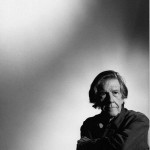* 5. September 1912 in Los Angeles; † 12. August 1992 in New York City
(scroll down for the german version)
John Cage (1912-1992) was a singularly inventive, highly influential, and much beloved American composer, writer, philosopher, and visual artist. Beginning around 1950, and throughout the passing years, he departed from the pragmatism of precise musical notation and circumscribed ways of performance.
His principal contribution to the history of music is his systematic establishment of the principle of indeterminacy: by adapting Zen Buddhist practices to composition and performance, Cage succeeded in bringing both authentic spiritual ideas and a liberating attitude of play to the enterprise of Western art.
His aesthetic of chance produced a unique body of what might be called “once-only” works, any two performances of which can never be quite the same. In an effort to reduce the subjective element in composition, he developed methods of selecting the components of his pieces by chance, early on through the tossing of coins or dice and later through the use of random number generators on the computer, and especially IC (1984), designed and written in the C language by Cage’s programmer-assistant, Andrew Culver, to simulate the coin oracle of the I Ching.
Cage’s use of the computer was creative and procedural, and resulted in a system of what can easily be seen as total serialism, in which all elements pertaining to pitch, noise, duration, relative loudness, tempi, harmony, etc., could be determined by referring to previously drawn correlated charts. Thus, Cage’s mature works did not originate in psychology, motive, drama, or literature, but, rather, were just sounds, free of judgments about whether they are musical or not, free of fixed relations, free of memory and taste.
His most enduring, indeed notorious, composition, influenced by Robert Rauschenberg’s all-black and all-white paintings, is the radically tacet 4’33″ (1952). Encouraging the ultimate freedom in musical expression, the three movements of 4’33″ are indicated by the pianist’s opening and closing of the piano key cover, during which no sounds are intentionally produced. It was first performed by the extraordinarily gifted pianist and long-time Cage associate, David Tudor, at Maverick Hall in Woodstock, N.Y., on Aug. 29, 1952.
“In the nature of the use of chance operations is the belief that all answers answer all questions.” ~John Cage
John Cage (1912–1992) war ein außergewöhnlich kreativer, höchst einflussreicher, aber auch geliebter amerikanischer Komponist, Autor, Philosoph und Künstler. Seit 1950 entfernte sich Cage immer weiter von der pragmatischen Art, Musik einer präzisen Notation folgend in fest vorgegebenen Aufführungsritualen zu machen. Sein Hauptbeitrag zur Musikgeschichte ist die systematische Etablierung des Prinzips der Unvorhersehbarkeit. Cage übertrug Zen-buddhistische Methoden auf Komposition und Aufführung von Musik. Damit gelang es ihm, nicht nur authentisch spirituelle Ideen, sondern auch eine freie Spielweise in die westliche Kunst einzuführen.
Seine Ästhetik des Zufalls führte zu einem einmaligen Oeuvre aus „Einmal-Werken“, die niemals exakt gleich aufgeführt werden können. Gleichzeitig wollte Cage das subjektive Element in der Komposition zurückdrängen. Also erfand er Methoden, die Elemente seiner Stücke durch Zufall auszusuchen. Anfänglich warf er Münzen oder Würfel, später verwendete er dazu Zufallszahlengeneratoren auf dem Computer. Letzteres gilt insbesondere für IC (1984), das Andrew Culver, Cages Programmierer und Assistent, als Simulation des Münzorakals des I Ging entwarf und in C implementierte.
Cage verwendete den Computer kreativ und prozesshaft. So entstand ein künstlerisches System, dass man mühelos als total seriell verstehen kann. Elemente wie Tonhöhe, Hintergrundgeräusche, Tondauer, relative Lautstärke, Tempi, Harmonie usw. wurden nunmehr durch vorgefertigte Tabellen festgelegt. Cages reifere Werke fußen mithin nicht auf Psychologie, Thematik, Dramatik oder Literatur. Ob musikalisch oder nicht, sind sie schlicht nur Klänge – frei von jedem Urteil, frei von fixen Beziehungen, frei von Erinnerung und Geschmack.
Cages bekannteste, ja berüchtigtste Komposition ist das radikal stille 4’33” aus dem Jahr 1952, das von Robert Rauschenbergs Schwarzweißmalerei inspiriert wurde. Seine drei Sätze werden bloß durch das Öffnen und Schließen der Tastenklappe angedeutet und verweisen so auf die radikale Freiheit des musikalischen Ausdrucks. Die Sätze selbst bestehen aus keinen planvoll erzeugten Klängen. Das Stück wurde am 29. August 1952 vom hochbegabten Pianisten und Langzeitfreund Cages David Tudor in der Maverick Hall in Woodstock im Staat New York uraufgeführt.
Übersetzung/translation: Thomas Raab


Leave your comment
You must be logged in to post a comment.